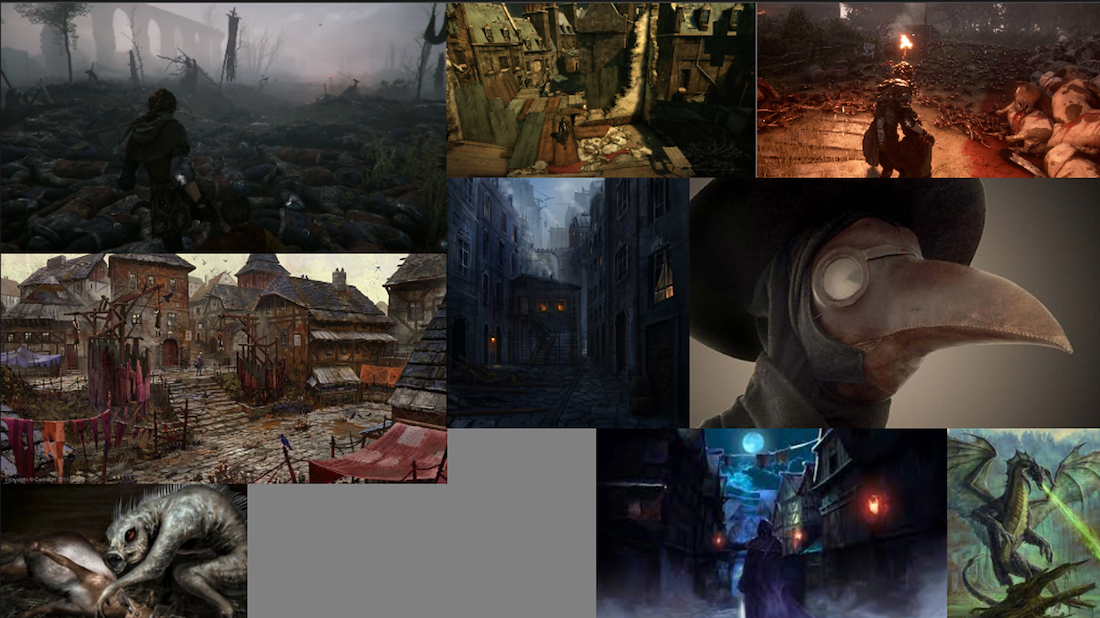
— PROJECT NAME
Le Serment du corbeau
— ROLE
Narrative designer
Writer
— DATE
November – December 2022
— SOFTWARES USED
Notion
Twine
"Le Serment du corbeau" is a narrative adventure made using Twine as part of a game design course at UQAT. Our team had to create an original scenario, including a narrative bible of our fictional universe. We then had to write and simulate part of our story in Twine with as little as 10000 words. Our story's title takes inspiration from the famed "Hippocratic oath" and the crow-like appearance of plague doctor masks.
The story is about Fulko, a small-time plague doctor with little means, who must find the source of recent plague infections in the town of Beaubéliard. To do this, he must go up against profiteering colleagues, a distrustful population and the religious order currently ruling the city.
This project was made by a team of 4 people (myself included):
- - Félix Marcoux (me)
- - David Céré
- - Joé Boulet
- - Maxime Rioux
The final Twine file can be downloaded here. You can also reach the full Notion page here.
Narrative design
We first hesitated between 3 scenarios before settling with a half-medieval, half-renaissance setting. To start, I contributed to the story’s narrative bible, establishing locations, factions and possible characters for our story.
Our goal was to immerse players in a world where a majority of doctors were corrupt, thus making people suspicious of medicine. Furthermore, we decided our world would include magical creatures in small number, so as to retain more fantasy elements than just the era.
Once the bases of our world was established, I started working on the different factions. Most were planned to be antagonistic, so as to put pressure on the player and make him feel like an underdog. As such, a powerful but corrupt plague doctor organization seemed perfect. Corrupt clergymen also fit the bill, since they could claim their god was the solution to the plague.
Finally, I researched different character archetypes to come up with a cast of characters. Most were cut from the final scenario, but 4 were defined a little more, so as to guide us later when writing their dialogues.



While we only had to put some story beats of our story into Twine, we still had to define every story beat of the full story. I participated in defining our full story flowchart with a conclusion I felt was satisfactory.
We opted to start the Twine file from act 2, since it was the one that held the most potential for player interactions. Those represented chapter 4 to 7 in our global flowchart. For each chapter, we created a sub-flowchart showing how the Twine file would progress, the variable names, which characters would be met and what the player would gain from each interaction.
Finally, once our narrative structure was established, I started on writing the sub-flowchart I had spent the most time designing and that I had assigned to myself (chapter 5). It constituted the largest part of the story and I wanted to make sure the research of clues of plague outbreak causes was gradual, interesting and coherent.
Since this chapter was so important, I went above and beyond to write and correct about 5200 words instead of the 2500 that was required for this part. I am proud of this feat, considering it was done in 2 weeks in parallel with the submission of many other important school projects.





Global narrative flowchart

The narrative flowchart of the sub-mission attributed to me
Programming
This project was the first time I used Twine but I was able to adapt well because of my past experiences with HTML and CSS.
My biggest hurdle when working with Twine was collaborative work. Since our version of Twine didn’t seem to support it, we had to work separately on our respective part, but had to communicate our progress quickly after every change. Discord helped us a lot to give updates of our progress to the others and Notion was useful to remember the exact variable names we used.
I personally wrote my entire first draft in Word before transcribing it in Twine. This made me spend as less time as possible on Twine which could be used by my coworkers to work on their part.

In general, I am satisfied of my work on this project. The worries I first had soon disappeared and each of my team members did a great job telling their part of our story. This experience made me want to use Twine further for other stories I had in mind.
